Maxxis High Roller
Diameters Offered: 27.5’’ and 29’’
Stated Width: 2.4’’
Version Offered: DH Casing / 3C MaxxGrip Rubber (more variants coming soon)
Blister’s Measured Width (on 30 mm internal-width rim):
- 2.27‘’’ (casing)
- 2.38’’(tread)
Blister’s Measured Weight (29’’ diameter): 1,410 and 1,419 g
MSRP: $105

Intro
A lot of Maxxis’ DH racers had been spotted on a new tire at the World Cup races this season, so it wasn’t much of a surprise when that tire formally launched, but the name caught me off guard. Sure, the High Roller name has long held a place in Maxxis’ lineup, and the High Roller II had faded into obscurity after more than a decade on the market, but the new High Roller (Maxxis isn’t officially calling it the High Roller III) looks nothing like the earlier two variants.
The original High Roller cornered exceptionally well, especially in drier, firmer conditions, and rolled pretty quickly, but its braking performance… left a lot to be desired. The High Roller II’s braking performance was vastly better than that of the original, and it still cornered pretty well, but it was quickly overshadowed by the Minion DHR II that was released a short time later and never really achieved widespread popularity — despite being quite a good tire in the right conditions.
So from that angle, maybe it’s not such a big surprise that Maxxis went in a different direction with the new High Roller — and it looks to fill a distinct hole in their lineup in the process. Maxxis says that the new tire is the new go-to tire — both front and rear — for their DH racers in most conditions short of super dry and firm (where an Assegai front / DHR II Rear combo is the default), or wet enough to merit the Shorty mid-spike. Let’s see what they’ve come up with.
Design
At a quick glance, the High Roller actually looks a lot like the Shorty mid-spike, despite their very different intended conditions. As Maxxis puts it, the Shorty is meant for “dry and loose or wet and sloppy” trails; the High Roller is for “intermediate enduro and downhill conditions.”
(I’m just going to call the new tire the “High Roller” since Maxxis isn’t using the High Roller III name. From here on out I’m talking about the new one, not the original.)
Like the Shorty, the High Roller uses two-wide rows of square(ish) center knobs and similarly-blocky side ones with no intermediate transition knobs to get in the way of side knob engagement. However, the dimensions and designs of those knobs differ in some important ways that point to the differences in intended use. The High Roller’s center knobs are slightly bigger (in terms of length and width) but are substantially shorter than those of the Shorty, and are also slightly more tightly spaced. The High Roller’s side knobs are much wider, longer, less tall, and more tightly spaced than those of the Shorty.
The High Roller’s center knobs also alternate between using lateral and longitudinal sipes (the Shorty’s are all lateral) and are set at two different row widths as compared to the Shorty’s three. Both tires use alternating siped and non-siped side knobs, but the Shorty gets a full-length longitudinal sipe on every third knob whereas the High Roller only has a partial-length one on every other knob; the non-siped High Roller side knobs also feature a slight L-hook for braking bite a-la Minion DHF / DHR II, though the High Roller version is considerably shallower.
The High Roller’s side knob design is closer to that of the Assegai than any of the aforementioned tires, but the High Roller’s knobs are slightly wider for (theoretically) better lateral support, and the L-shaped knobs don’t feature any of the partial-width lateral sipes of the Assegai ones. The Assegai’s side knobs are a little bit more tightly spaced.
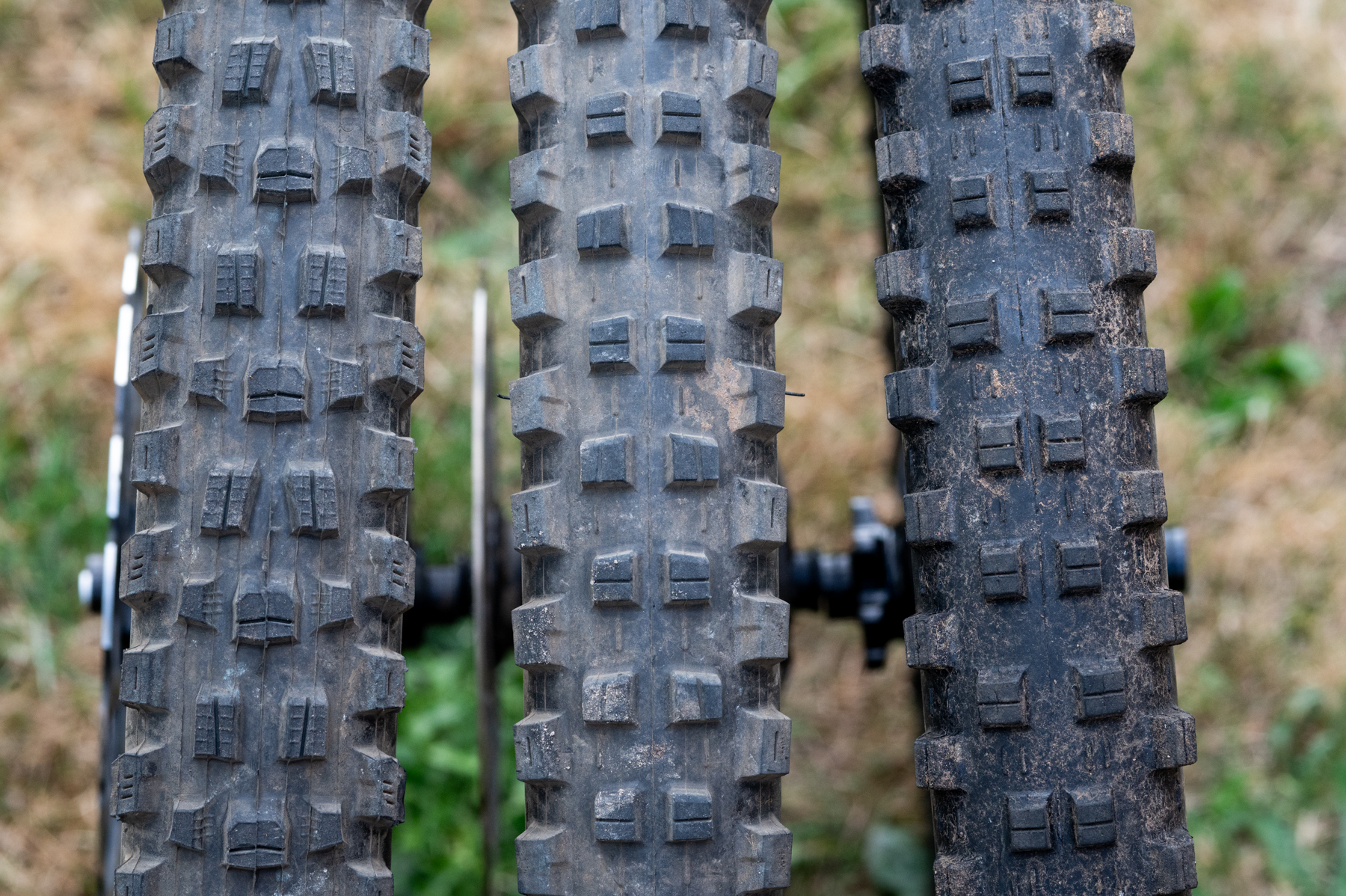
That’s a recipe that seems quite promising on paper. The High Roller’s fairly open center tread looks like it should penetrate softer dirt much better than the Assegai, and the High Roller has a much more open channel between the center and side knobs to help the tire really dig in when leaned over. Compared to the Shorty, the High Roller’s shorter center knobs and bigger, more tightly spaced side ones look like they should be a lot more supportive / less vague and squirmy on firmer surfaces.
The only design attribute that gives me a little bit of pause is the fact that the High Roller’s side knobs are angled slightly outward (i.e., with the leading edge set wider than the trailing one). I’ve generally found tires with a similar arrangement (most notably the Schwalbe Magic Mary) to feel vague and unpredictable in how they signal that you’re pushing the limit of grip on the side knobs, and to be quick to step out if you have to take a stab at the brakes while leaned over. Granted, the High Roller’s angling of the knobs is a lot more subtle than that of the Magic Mary, but it’s still interesting to see Maxxis going that route when they historically haven’t for the most part.
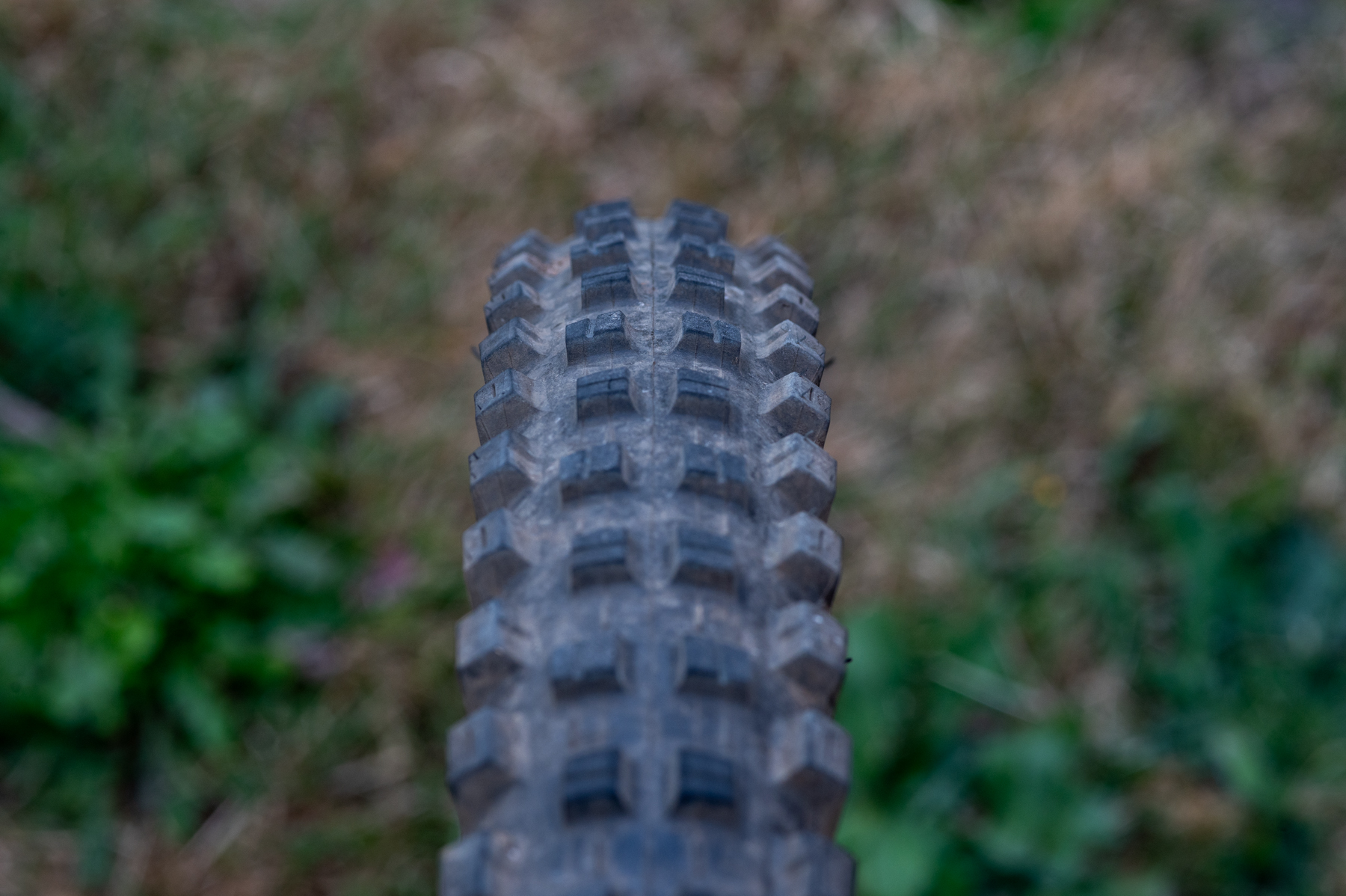
FULL REVIEW
I was pretty excited when I first laid eyes on the new High Roller. In the spring and fall, I spend a lot of time riding in conditions where drier-condition tires pack up and cease to brake well, but where the dirt isn’t quite wet and soft enough for a mid-spike tire to be ideal, either.
I’ve struggled to find a tire (at least, one I really like) that bridges that gap and Maxxis says that’s precisely what the new High Roller is for. Its tread pattern looked promising on paper, but would that promise be borne out on the trail? I was eager to find out.
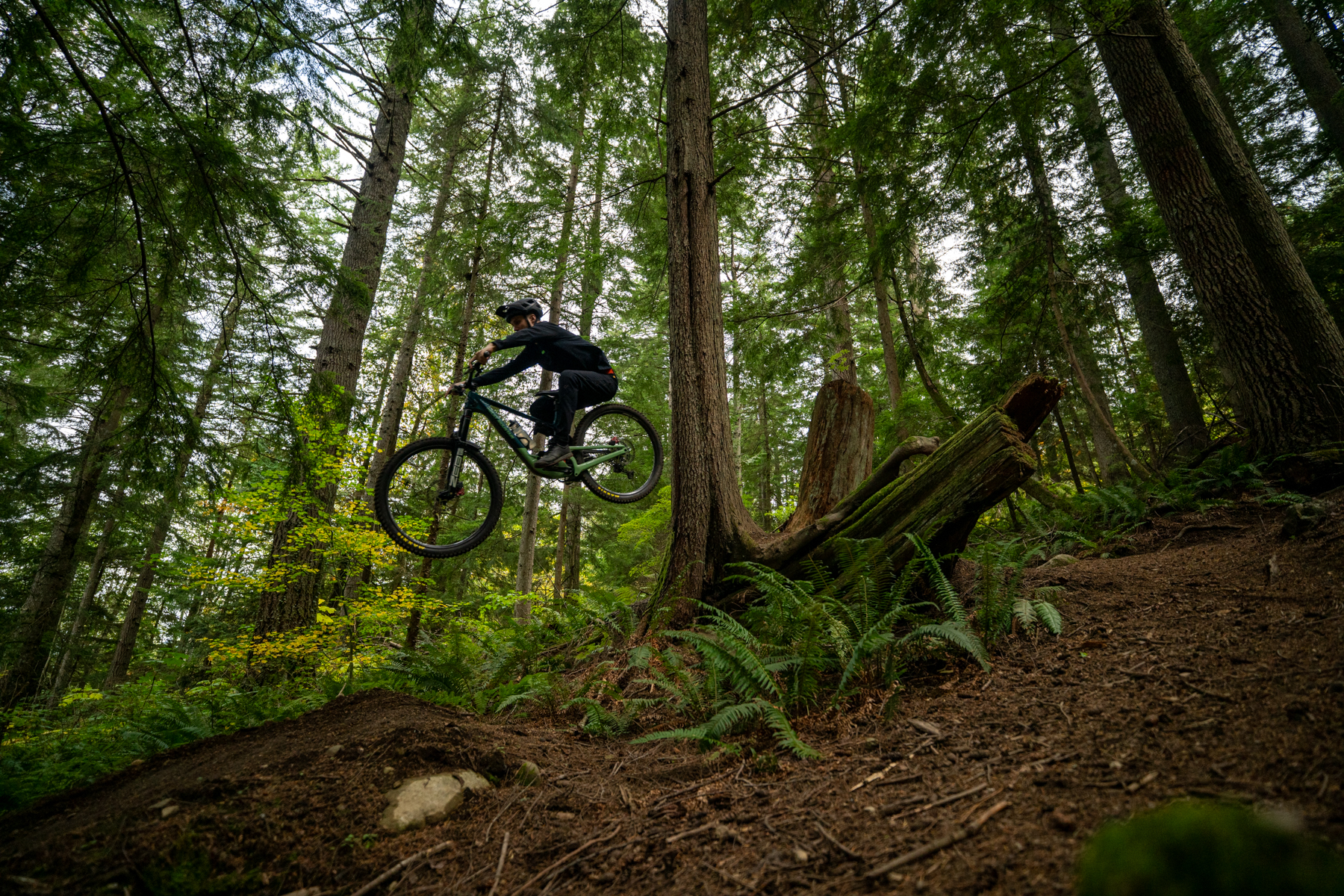
On-Trail Performance
The first month or so of my testing was, frankly, in pretty non-ideal conditions for the new High Roller. I started spending time on a pair in mid-July when dry, hard summer conditions were in full effect — distinctly not the sort of intermediate conditions it’s really meant for.
The High Roller would not be my first choice for the mostly hard, moderately loose and dusty dirt they were subjected to in those early days, but it fared a lot better than I expected just from looking at the tread pattern.
The center knobs are decidedly spikier and more widely spaced than would be ideal for those sorts of conditions, and particularly under heavy braking on hardpack, they can start to squirm a bit. But I think the High Roller’s real saving grace in those conditions is that its side knobs are much blockier and more tightly spaced — a pairing of center and side knob designs that’s somewhat unconventional.
It works quite well, though. A little bit of vague braking feel — again, in conditions that the High Roller really is not meant for — is pretty manageable. But most mid-spike tires (e.g., the Maxxis Shorty) struggle to get consistent and predictable cornering grip on firmer surfaces, and that’s not the case with the High Roller. Again, there are much better options for an aggressive gravity tire specifically meant for hard-to-dusty conditions (e.g., Michelin DH16 and Maxxis DHRII), but the High Roller does commendably well for what it is.
With that in mind, I was happy enough to keep spending some time on the High Roller at the tail end of summer — in conditions where I’d have zero interest in riding a Maxxis Shorty or Continental Argotal, for example. But I was mostly biding my time until some rain came and the trails started to soften up. Unsurprisingly, the High Roller started to truly feel like the right tool for the job once the moisture arrived.

In my recent review of the Michelin Wild Enduro MS and DH22 (nearly the same tire, just in a lighter and burlier construction, respectively), I talked about the benefits of a tire that splits the difference between mid-spike options and true all-rounders, particularly in the spring and fall where I live in Western Washington.
Until fairly recently, I frankly haven’t had an option that I liked very much in that slot. But the Michelin siblings are excellent there, and the High Roller is another very strong option — but the exact details of what they do (and don’t do) best differ a bit.
[For this next bit, I’m just going to refer to the DH22, in the interest of keeping the language simpler since I’ve been testing in the High Roller in the more comparable Maxxis DH casing. The DH22 and Wild Enduro MS’s performance is really just differentiated by their casings, so everything I’m about to say about the DH22 applies to the Wild Enduro MS, too. Check out our Full Review of those Michelin tires for the nitty gritty details.]
In very broad strokes, the High Roller feels most ideally suited for conditions that are a notch softer and more damp than the DH22’s ideal conditions. Both work really well as the sort of intermediate-condition tire that I’ve been pining for, but with different relative strengths and weaknesses.
As I mentioned, braking on harder surfaces is not the High Roller’s strong suit, but it does quite well once the ground is soft enough for its spikier center knobs to really dig in.

(That doesn’t translate to loose and dusty conditions as well. My theory is that the comparatively spiky center knobs work a lot better when the dirt still sticks together / has more structure to it, rather than just being full-on moon dust.)
The DH22’s braking performance on harder / dustier surfaces is substantially better, but it starts to fall off sooner when things get properly muddy. The High Roller continues to brake very well past the point of the ground being saturated with water.
The story of the High Roller’s cornering performance is a little more complicated. Echoing my initial thoughts, its cornering grip is quite good on firm surfaces — surprisingly so, frankly — and only gets better as things start to soften up. Now, there is no shortage of tires that work well in soft-ish, tacky, hero dirt (it’s called hero dirt for a reason). Still, the High Roller stands out for cornering especially well in those (admittedly forgiving) conditions.
With the High Roller, there’s a little bit of a transition zone to lean through before its side knobs really start to hook up, but it’s much less pronounced than the Maxxis Minion DHF, for example. And once you get past that point, the levels of grip are very high. The High Roller also does a great job of communicating when you’re nearing the limit of its grip. In relatively good dirt, it’s tough to lean past the point that the side knobs still offer at least pretty good traction, and the High Roller does a nice job of breaking into a drift smoothly and predictably if you push through it.
Once the trails start getting really saturated and sloppy, the High Roller starts to get fairly loose and drifty but continues to do so in an intuitive fashion. If you’re looking for a tire that hooks up especially well in properly sloppy conditions, there are a number of better (but almost universally spikier / less versatile) options; if you’re game to let the bike drift a bit, the High Roller works really, really well.
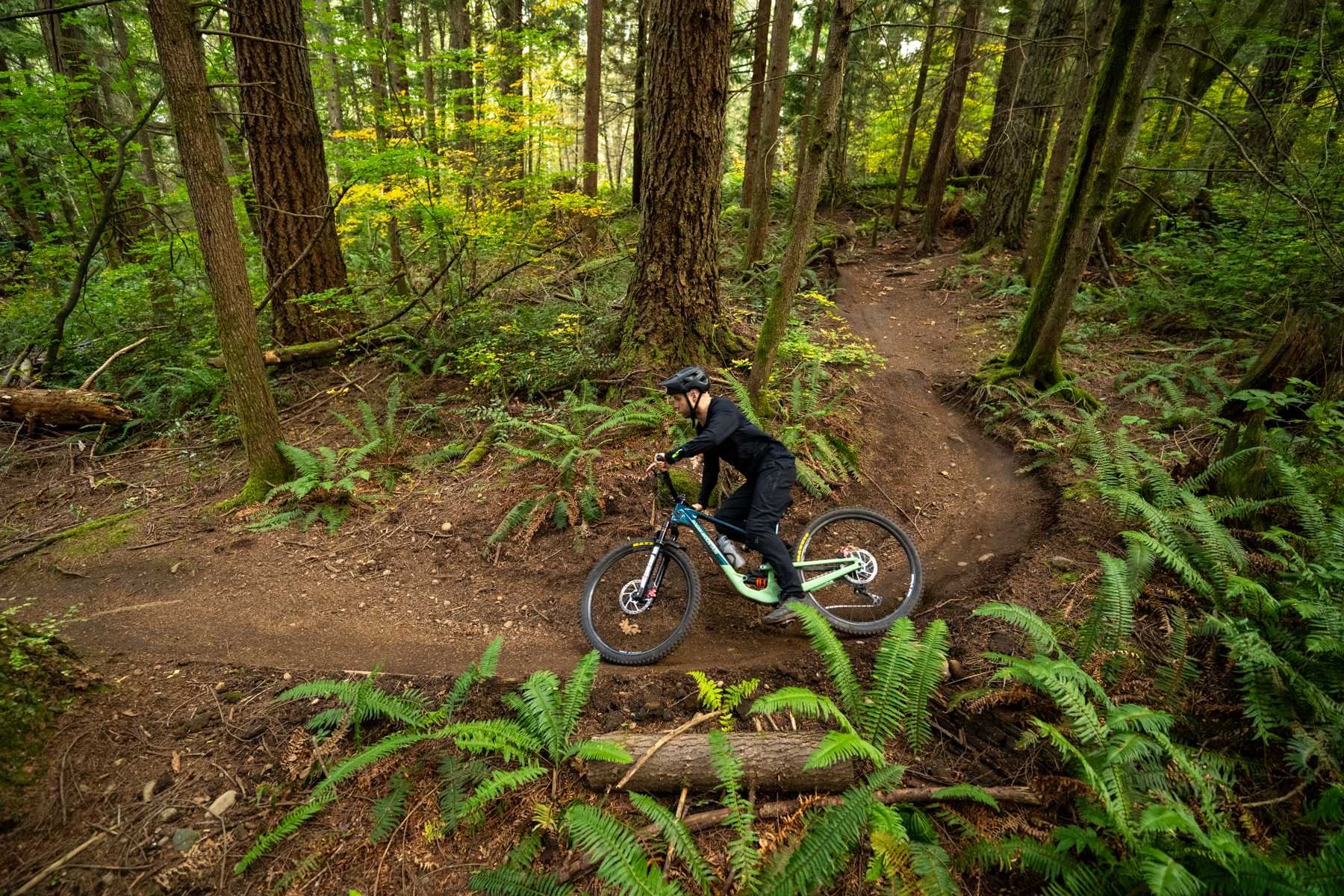
So, the High Roller offers a little less cornering grip than more mud-specific options like the Shorty once things get really wet. However, the level of sloppiness where I feel the need to take off the High Roller in favor of a real mud tire is pretty high. It takes a lot of water for conditions to be so uniformly muddy that there aren’t still firmer spots where a mid-spike tire gets squirmy and unpredictable. I find the High Roller’s tendency to drift some in the sloppiest bits to be a whole lot easier to control vs. managing a spikier tire on the harder spots where its knobs are folding over and getting squirmy. There’s certainly a degree of personal preference at play there, but at least for my own, I’m quite happy running the High Roller in pretty wet, gross conditions.
Let’s wrap by bringing it back around to the DH22 comparison — which is the closest / best competitor that I’ve been on to date. Compared to the DH22, the High Roller starts to get a little looser feeling in corners slightly sooner as moisture levels rise, but the two tires’ actual levels of grip around that point are pretty similar. They just accomplish it in slightly different ways. The High Roller brakes better at the wetter end of the spectrum, while the DH22 fares better when things are drier and firmer. And the High Roller seems to clear / shed really sticky, high-clay-content mud slightly better. Neither is all that fast rolling in the grand scheme of things, but the High Roller feels slightly quicker on relatively firm surfaces; it’s tough to tease out any real differences in that regard once things soften up.
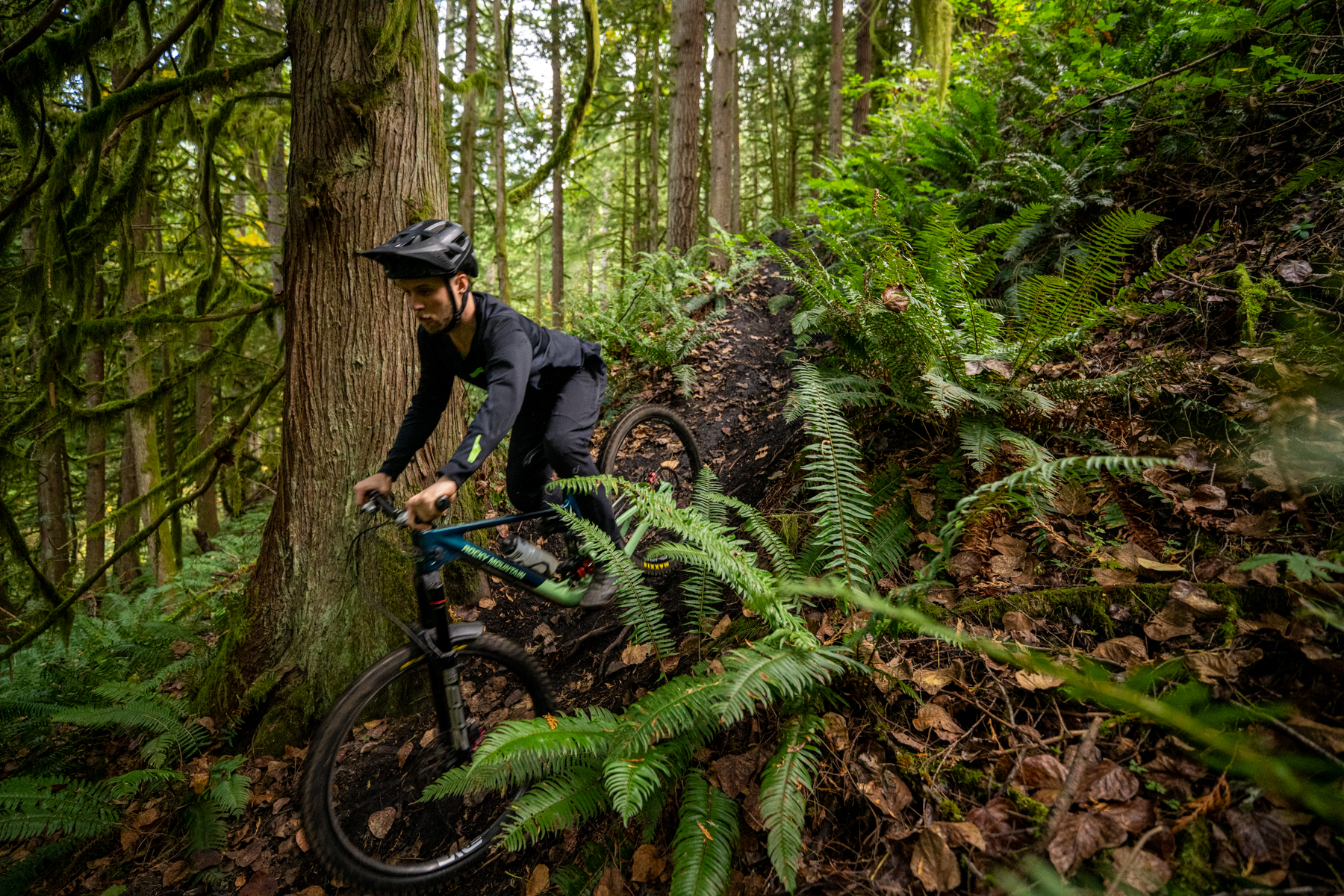
Bottom Line
The new High Roller very effectively fills what had been a notable gap in Maxxis’ tire lineup — and the gravity MTB tire market more broadly. Maxxis’ description of it as “a versatile choice when conditions are soft or loose, but don’t quite warrant a mud spike” is on point.
“Soft and loose” conditions come in both dry + dusty and wet + muddy forms, and the High Roller feels better suited to the latter. However, that’s a set of conditions that I spend a ton of time in, and the High Roller is one of the best options I’ve tried to date for them. The High Roller is a pretty aggressive, not particularly fast-rolling tire, and it might be a bit much for folks on rolling, mellower trails where carrying speed is at more of a premium. But for gravity-oriented use, it’s quite impressive.

Your impressions mirror my own. I ran the High Roller front and DHRII rear for a dozen rides in the fall and then started running High Roller both front and rear as rainy season set in. I really like this tire. It’s my new go-to for the rainy majority of the year in the PNW.
Nice. Glad they’re working for you too!
Nice review, David.
Could you elaborate on the Argotal vs. High roller comparison? I personally really liked the Argotal for steep and loose dust. The side knobs felt consistent for cornering at all different lean angles. And predictable while slowing down to enter the turns. Could the High roller be even better for the loose dry summer? (I don’t ride hard pack trails with berms, majority is steep and loose)
Cheers